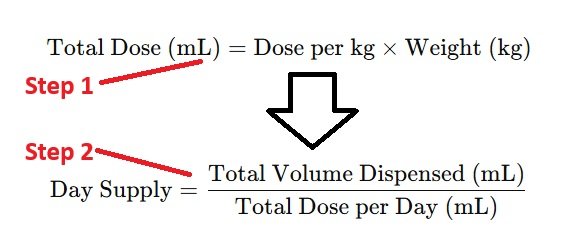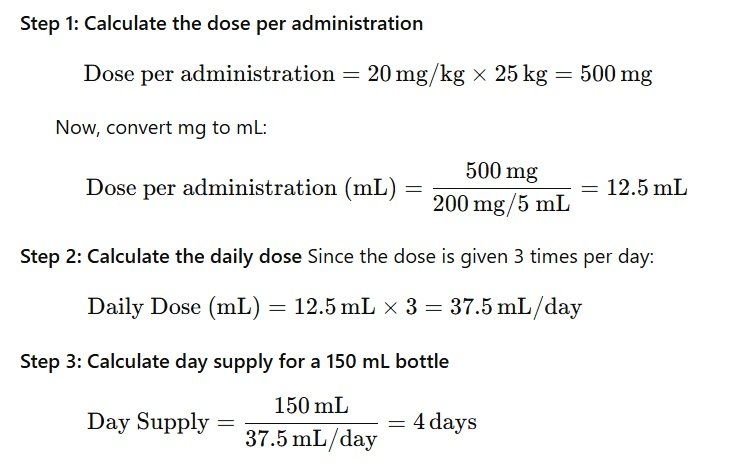Day Supply Calculations (Solutions, Suspensions, Syrups)
Table of Contents
Day supply calculations for liquids are used to determine how many days a prescribed liquid medication will last based on the prescribed dose and quantity dispensed.
This calculation is essential for ensuring the patient receives the correct amount of medication for the intended duration, avoiding early refills or medication shortages.
Day supply becomes especially important for controlled substances, insurance claims, pediatric dosing, and PRN (as-needed) medications.
This calculation is essential for ensuring the patient receives the correct amount of medication for the intended duration, avoiding early refills or medication shortages.
Day supply becomes especially important for controlled substances, insurance claims, pediatric dosing, and PRN (as-needed) medications.
Day Supply Calculation Formula – Liquids

Standard Daily Dosing (QD, BID, TId, QID)
QD (Once Daily Dose)
- Prescription: Take 10ml once daily
- Quantity Written/Dispensed: 100ml

BID (Twice Daily Dose)
- Prescription: Take 5ml twice daily
- Quantity Written/Dispensed: 150ml

Q6H (Every 6 Hours)
- Prescription: Take 7.5ml Every 6 Hours
- Every 6 Hours = 4 times a day
- Quantity Written/Dispensed: 180ml

Q8H (Every 8 Hours)
- Prescription: Take 5 mL every 8 hours
- Every 8 Hours = 3 times a day
- Quantity Written/Dispensed: 120ml

PRN Dosing (As Needed)
PRN (pro re nata) means the medication is taken only when needed, not on a fixed schedule. In liquid form, this requires calculating the maximum possible day supply based on the highest allowable frequency.
Formula for PRN Liquid Dosing

Use the maximum frequency allowed when calculating PRN day supply (e.g., “every 4–6 hours as needed” → max 6 times/day).
Prescription 1:
- Take 10 mL every 6-8 hours as needed for cough
- Dispensed: 120 mL bottle
- Max doses per day = 24 ÷ 6 = 4 doses/day
- Day Supply = 120 ÷ (10 × 4) = 120 ÷ 40 = 3 days
Prescription 2:
- Take 5 mL every 4 to 6 hours as needed for fever
- Dispensed: 240 mL
Calculation:
- Max doses per day = 24 ÷ 4 = 6 doses/day
- Day Supply = 240 ÷ (5 × 6) = 240 ÷ 30 = 8 days
Weight-Based Dosing for Liquids
Weight-based dosing is often used in pediatrics, critical care, and certain adult conditions to ensure that the patient receives the correct amount of medication based on their weight.
The dose is typically calculated as milligrams (mg) or milliliters (mL) per kilogram (kg) of body weight. This helps ensure the proper therapeutic dose for the individual patient.
The dose is typically calculated as milligrams (mg) or milliliters (mL) per kilogram (kg) of body weight. This helps ensure the proper therapeutic dose for the individual patient.
Formula for Weight-Based Dosing

Question 1: Pediatric Weight-Based Dosing for Acetaminophen
Prescription:
Prescription:
- Acetaminophen suspension 15 mg/kg/day, divided into 4 doses for a 20 kg child
- Concentration: 160 mg/5 mL

Question 2: Weight-Based Dosing for an Antibiotic
Prescription:
Prescription:
- Amoxicillin 20 mg/kg/day, divided into 3 doses for a 25 kg child
- Concentration: 200 mg/5 mL

Key Points about Weight-Based Dosing:
- Patient’s weight is a crucial factor in calculating the right dose.
- Age and condition of the patient (especially in pediatric patients) are important when using weight-based dosing.
- Liquid medication concentrations need to be converted to determine the correct amount of medication in mL.
- Adjusting the frequency of doses (e.g., BID, TID) or dosing schedule (e.g., weight-based tapering) may change the day supply.
Tapering Dose for Liquids
A tapering dose refers to gradually reducing the dosage of a medication over a period of time. This method is often used for medications that could cause withdrawal symptoms, or for those that require a slow reduction in dosage to avoid adverse effects (e.g., steroids, benzodiazepines). The tapering schedule usually involves taking a higher dose initially, followed by progressively smaller doses until the medication is discontinued.
- The liquid dosage is adjusted over a specific period.
- Each phase of the tapering schedule has a defined daily dose.
- Day supply is calculated by adding the total volume consumed in each tapering phase.
Prescription 1:
- Prednisone 20 mg/mL
- Tapering Schedule:
- 10 mL daily for 3 days
- 5 mL daily for 3 days
- 2.5 mL daily for 3 days
- Dispense: 55 mL
- First Phase (10 mL daily for 3 days): 10mL/day × 3 days = 30mL
- Second Phase (5 mL daily for 3 days): 5mL/day × 3 days = 15mL
- Third Phase (2.5 mL daily for 3 days): 2.5mL/day × 3 days = 7.5mL
- 30mL + 15mL + 7.5mL = 52.5mL
- Total volume dispensed: 55 mL
- Total volume required for tapering: 52.5 mL
Prescription 2:
- Medication: Hydrocodone/acetaminophen 5 mg/325 mg per 5 mL
- Tapering Schedule:
- 10 mL daily for 4 days
- 7.5 mL daily for 4 days
- 5 mL daily for 4 days
- Dispense: 90 mL
- First Phase: 10 mL daily for 4 days
- 10 mL × 4 days = 40 mL
- Second Phase: 7.5 mL daily for 4 days
- 7.5 mL × 4 days = 30 mL
- Third Phase: 5 mL daily for 4 days
- 5 mL × 4 days = 20 mL
- Total Volume Needed=40mL+30mL+20mL=90mL
Concentration Changes (Dilutions/Compounded Liquids)
A tapering dose refers to gradually reducing the dosage of a medication over a period of time. This method is often used for medications that could cause withdrawal symptoms, or for those that require a slow reduction in dosage to avoid adverse effects (e.g., steroids, benzodiazepines). The tapering schedule usually involves taking a higher dose initially, followed by progressively smaller doses until the medication is discontinued.
- The liquid dosage is adjusted over a specific period.
- Each phase of the tapering schedule has a defined daily dose.
- Day supply is calculated by adding the total volume consumed in each tapering phase.
Simple Dilution with Day Supply
Scenario: A pediatrician prescribes “Amoxicillin 125 mg/5 mL, take 3 mL three times daily for 10 days.” The pharmacy only has 250 mg/5 mL in stock and will dilute it 1:1 with water.Questions:
- What is the new concentration after dilution?
- What volume should be dispensed?
- What is the day supply?
- New concentration:
- Original: 250 mg/5 mL
- Diluted 1:1 → 250 mg/10 mL = 25 mg/mL (125 mg/5 mL) (Matches prescribed concentration)
- Total volume needed:
- Daily dose: 3 mL × 3 = 9 mL/day
- For 10 days: 9 mL × 10 = 90 mL
- Day supply calculation:
- 90 mL dispensed ÷ 9 mL/day = 10 days
Weight-Based Compounding with Day Supply
Scenario: A compounded “Spironolactone 5 mg/mL oral suspension” is prescribed for a 12 kg child at 1 mg/kg/day divided BID. The total volume dispensed is 120 mL.Questions:
- What is the daily dose in mL?
- What is the day supply?
- Answers & Explanations:
- Dose: 1 mg/kg × 12 kg = 12 mg/day
- Volume: 12 mg ÷ 5 mg/mL = 2.4 mL/day
- 120 mL ÷ 2.4 mL/day = 50 days
PRN Liquid Medication with Max Day Supply
Scenario: “Diphenhydramine 12.5 mg/5 mL, take 5-10 mL every 6 hours PRN for itching” is dispensed in a 240 mL bottle.Questions:
- What is the maximum day supply?
- If the patient uses only 5 mL/day, what is the day supply?
- Max day supply (worst-case):
- Max daily dose: 10 mL × 4 doses = 40 mL/day
- 240 mL ÷ 40 mL/day = 6 days
- Conservative day supply:
- 240 mL ÷ 5 mL/day = 48 days (Note: Insurers typically use the max day supply for PRN meds.)
Concentration Change with Stability Limit
Scenario: A “Cefdinir 250 mg/5 mL” suspension is reconstituted to 125 mg/5 mL (to improve palatability). The stability is 14 days refrigerated. The dose is “5 mL twice daily.”Questions:
- What is the day supply for a 100 mL bottle?
- Does stability limit the day supply?
- Day supply calculation:
- Daily volume: 5 mL × 2 = 10 mL/day
- 100 mL ÷ 10 mL/day = 10 days
- Stability consideration:
- 10-day supply ≤ 14-day stability → Acceptable (If day supply exceeded stability, the pharmacist would dispense a smaller quantity.)
Multi-Ingredient Compound with Day Supply
Scenario: A “Magic Mouthwash” compound contains:- Diphenhydramine 12.5 mg/5 mL
- Lidocaine 2% (20 mg/mL)
- Maalox 30 mL Total volume = 150 mL. Directions: “Rinse with 5 mL QID.”
- What is the day supply?
- How much lidocaine is delivered per dose?
- Day supply:
- Daily volume: 5 mL × 4 = 20 mL/day
- 150 mL ÷ 20 mL/day = 7.5 days (Round to 7 days for billing)
- Lidocaine per dose:
- Concentration: 2% = 20 mg/mL
- Per 5 mL dose: 20 mg/mL × 5 mL = 100 mg


